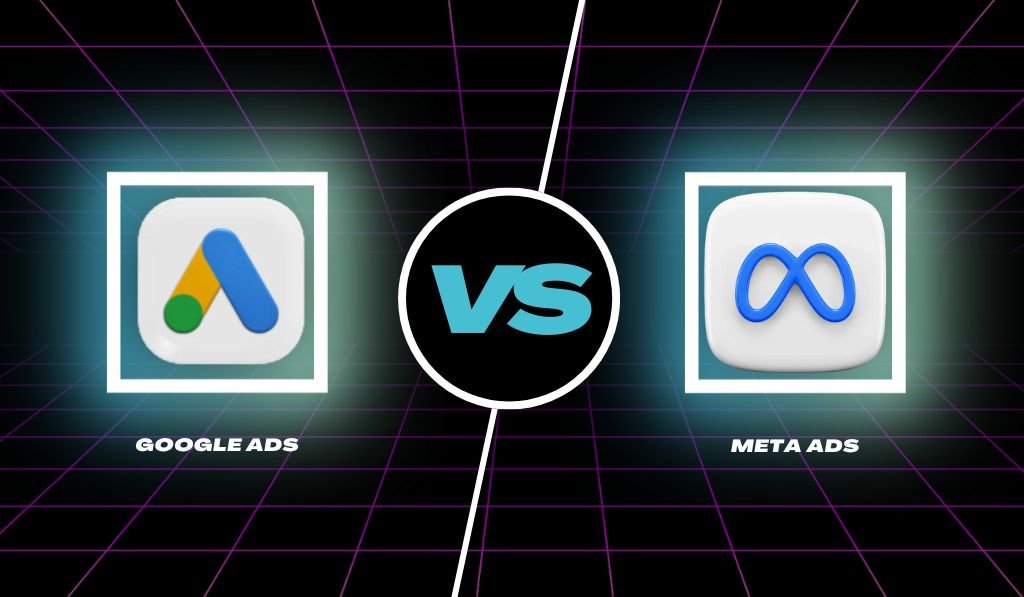When it comes to running paid campaigns, two platforms dominate most marketing conversations — Meta Ads (Facebook & Instagram) and Google Ads (Search, Display, and YouTube). Yet, many businesses treat them as if they’re interchangeable.
They’re not.
Each platform has a distinct logic, user psychology, and marketing advantage. Understanding how and when to use each will help you save money, gain traction, and ultimately convert better.
Let’s break it down.
The Core Difference: Intent vs Attention
Google is where people search. Meta is where people scroll.
That one insight can shape your entire strategy.
- Google Ads is built on intent — people know what they want and are actively looking for it.
- Meta Ads is built on discovery — people don’t plan to buy, but your content can influence them emotionally or through repetition.
At the heart of this comparison lies a critical truth:
Each platform fits a different role in the marketing funnel. Let’s look deeper.
META ADS (Facebook & Instagram)
Best for: Brand Awareness, Impulse Products, Retargeting
Meta is a social platform. People are there to relax, browse, laugh, react, and engage — not necessarily to buy. So as an advertiser, your job is to blend in and hook attention without disrupting the feed experience.
When Meta Works Best:
- Top of Funnel (TOFU) — Creating awareness
- Emotional, visually-driven products (beauty, food, fashion, spiritual items)
- Low-ticket or impulse buys (₹500 – ₹2000 products/services)
- Reels, Stories, Carousels, Short-form Videos — native-looking content
- Retargeting site visitors or page engagers — extremely cost-effective
Targeting Logic
Meta targets based on user interests and behavior — not what they type or search for.
So if someone is interested in “Astrology,” and you’re selling a pyrite bracelet, Meta may show them your ad… but it won’t know if they’re just curious or ready to buy.
When Meta Struggles
- Complex, rational buying decisions
- High-AOV or high-risk services (₹10K+)
- Generating serious leads from scratch
- B2B or trust-heavy sales
GOOGLE ADS (Search, Display, YouTube)
Best for: Lead Generation, Urgent Needs, High-Intent Buyers
Google is where people go to solve problems and find answers. It’s utility-driven — and that makes it a powerful tool for marketers who want to capture demand, not just create it.
When Google Works Best
Bottom of Funnel (BOFU) — Driving conversions
High-ticket services or time-sensitive offers
Keywords with buyer intent (e.g. “best IELTS coaching near me”)
Product with clear demand or search volume
Lead generation (consulting, real estate, healthcare, SaaS, etc.)
Targeting Logic
Google uses keywords and search behavior to target ads.
If someone searches “digital marketing course Bhubaneswar,” it knows this user is likely ready to explore options or convert.
When Google Struggles
- Generating awareness for a new category
- Emotion-driven, creative-first products
- Cold audiences with no brand recall
- Tight budgets in highly competitive keywords
Change block type or style
Move Heading block from position 32 up to position 31
Move Heading block from position 32 down to position 33
Change alignment
Change text alignment
Displays more block tools
The Perfect Strategy: Use Both — But Strategically
Let’s be real: the best marketers don’t choose between Google and Meta.
They combine both to build a full–funnel system.
Here’s a proven way to do that:
1.TOFU: Meta Ads for Attention
- Launch Reels or Story Ads with educational, emotional, or entertaining content
- Target interest-based audiences for reach and awareness
- Collect engagement, traffic, or video views
2. MOFU: Retarget with Meta + Educate via YouTube
- Show testimonial videos, FAQ reels, and offer ads to warm audiences
- Layer in YouTube video campaigns to build trust through long-form content
3. BOFU: Google Search for Conversion
- Target high-intent searchers
- Use lead forms, landing pages, or conversion-optimized pages
- Focus on keywords that show readiness to act (“best,” “near me,” “buy,” etc.)
Quick Comparison Table
| Feature | Meta Ads | Google Ads |
|---|---|---|
| User Intent | Passive / Discovery | Active / Intent-based |
| Best For | Awareness, engagement, impulse buys, retargeting | High-intent leads, urgent needs, high-ticket sales |
| Targeting | Interests & behavior | Keywords & search queries |
| Creative Type | Reels, images, carousels | Text, landing pages, YouTube videos |
| Funnel Role | TOFU / MOFU | BOFU |
| Cost Efficiency | Cheaper for reach and retargeting | More expensive per click, higher ROI for intent-driven campaigns |
Real Example: Selling a Coaching Program
| Funnel Stage | Platform | Campaign Idea |
|---|---|---|
| TOFU | Meta Ads | Reels on “Top 3 Study Abroad Myths” or “Day in the Life of a Student in Germany” |
| MOFU | Meta Retargeting | Testimonials, early bird offers, student reviews |
| BOFU | Google Search Ads | Target keywords like “best study abroad consultant in Delhi” or “IELTS coaching near me” |
This structure warms up cold audiences, nurtures them, and converts them at the moment of intent.
Final Thought
There’s no one-size-fits-all answer — because they’re not competing tools.
Meta is for emotions.
Google is for decisions.
Use Meta to spark curiosity.
Use Google to satisfy it.
Use both to build a marketing machine that doesn’t rely on luck — but logic.

